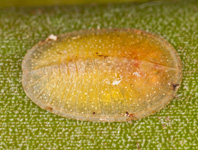Abstract
Antipatharians are still poorly documented in the southeastern Pacific, with just eleven species reported in Chilean waters, all of them distributed in subtidal areas from 70 to 2000 m depth (Häussermann & Försterra, 2007; Cañete & Häussermann, 2012; Araya et al. 2016a). Among the family Schizopathidae Brook, 1889, which is characterized by polyps elongated in the direction of the axis and having a transverse diameter of 2 mm or more (Opresko, 2002), the recently described deep-water genus Alternatipathes Molodtsova & Opresko, 2017, encompasses two recognized species, Alternatipathes alternata (Brook, 1889), reported from abyssal basins (2670 to 5089 m depth) of the Indian and Pacific Oceans, and Alternatipathes bipinnata (Opresko, 2005), known from a few specimens collected in deep waters (1130 to 2846 m) off the Pacific coasts of northern Mexico and southern USA (Opresko, 2005; Molodtsova & Opresko, 2017).
References
Araya, J.F. (2013) A new species of Aeneator Finlay, 1926 (Mollusca, Gastropoda, Buccinidae) from northern Chile, with comments on the genus and a key to the Chilean species. ZooKeys, 257, 89–101.
https://doi.org/10.3897/zookeys.257.4446
Araya, J.F. (2016) New records of deep-sea sea spiders (Chelicerata: Pycnogonida) in the southeastern Pacific. Marine Biodiversity, 46, 725–729.
https://doi.org/10.1007/s12526-015-0416-7
Araya, J.F., Aliaga, J.A. & Araya, M.E. (2016a) First record of Lillipathes ritamariae Opresko and Breedy, 2010 (Cnidaria: Antipatharia) in the southeastern Pacific Ocean. Marine Biodiversity, 1–5. [published online]
https://doi.org/10.1007/s12526-016-0591-1
Araya, J.F., Araya, M.E. & Cairns, S.D. (2016b) First record of the azooxanthellate coral genus Coenocyathus Milne-Edwards & Haime, 1848 (Anthozoa: Scleractinia) in the southeastern Pacific Ocean. Spixiana, 39, 23–27.
Araya, J.F., Araya, M.E., Mack, M. & Aliaga, J.A. (2016c) On the presence of Distichoptilum gracile Verrill, 1882 (Octocorallia: Pennatulacea) in the southeastern Pacific. Marine Biodiversity, 1–5. [published online]
https://doi.org/10.1007/s12526-016-0616-9
Araya, J.F., Catalán, R. & Aliaga, J.A. (2016d) A new deep-water Astyris species (Buccinoidea: Columbellidae) from the southeastern Pacific. Zootaxa, 4139 (1), 140–144.
http://doi.org/10.11646/zootaxa.4139.1.11
Araya, J.F. & Catalán, R. (2016) New record of Cuspidaria patagonica Smith, 1885 (Bivalvia: Cuspidariidae) in northern Chile. Gayana, 80, 191–193.
https://doi.org/10.4067/S0717-65382016000200204
Bravo, A., Försterra, G. & Häussermann, V. (2005) Fishing in troubled waters – evidence for higher diversity and high abundance of cold water corals along the Chilean coast. In: Brock, R. & George, R.Y. (Eds.), Deep-sea corals science and management. Proceedings of the third International Symposium on Deep-Sea Corals. Rosenstiel School of Marine and Atmospheric Science, University of Miami, Miami, pp 234.
Brook, G. (1889) Report on the Antipatharia collected by H.M.S. Challenger during the years 1873–1876. Report on the Scientific Results of the Voyage of H.M.S. Challenger During the Years 1873-76. Zoology, 32, 1–222.
Brugler, M.R., Opresko, D.M. & France, S.C. (2013) The evolutionary history of the order Antipatharia (Cnidaria: Anthozoa: Hexacorallia) as inferred from mitochondrial and nuclear DNA: implications for black coral taxonomy and systematics. Zoological Journal of the Linnean Society, 169, 312–361.
https://doi.org/10.1111/zoj.12060Cañete, J.I. & Haussermann, V. (2012) La vida colonial bajo el sistema de la corriente de Humboldt: corales de aguas profundas en el monte submarino O'Higgins I. Latin American Journal of Aquatic Research, 40, 467–472.
http://doi.org/10.3856/vol40-issue2-fulltext-23
Häussermann, V. & Försterra, G. (2007) Large assemblages of cold-water corals in Chile: a summary of recent findings and potential impacts. In: George. R.Y. & Cairns, S.D. (Eds.), Conservation and adaptive management of seamount and deep-sea coral ecosystems. Rosenstiel School of Marine and Atmospheric Science, University of Miami, Miami, pp. 195–207.
Molodtsova, T.N. & Opresko, D.M. (2017) Black corals (Anthozoa: Antipatharia) of the Clarion-Clipperton Fracture Zone. Marine Biodiversity, 47 (2), pp. 349–365.
https://doi.org/10.1007/s12526-017-0659-6
Opresko, D.M. (2002) Revision of the Antipatharia (Cnidaria:Anthozoa). Part II. Schizopathidae. Zoologische Mededelingen, 76, 411–442.
Opresko, D.M. (2005) New genera and species of antipatharian corals (Cnidaria: Anthozoa) from the North Pacific. Zoologische Mededelingen, 79, 129–165.
Reiswig, H. & Araya, J.F. (2014) A review of the Hexactinellida (Porifera) of Chile, with the first record of Caulophacus Schulze, 1885 (Lyssacinosida: Rossellidae) from the Southeastern Pacific Ocean. Zootaxa, 3889 (3), 414–428.
http://doi.org/10.11646/zootaxa.3889.3.4
Shorthouse, D.P. (2010) SimpleMappr, an online tool to produce publication-quality point maps. Available from: http://www.simplemappr.net (accessed 30 September 2016)

